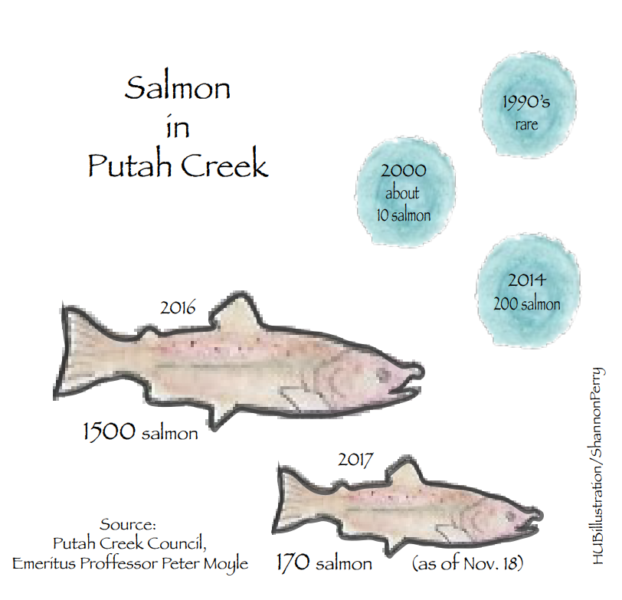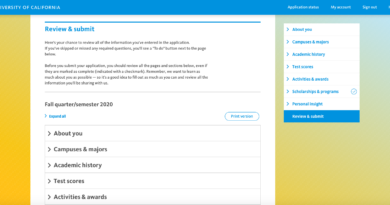Swarm of salmon spawns in local stream

By Shannon Perry,
BlueDevilHUB.com Staff–
A forceful splashing sound sent Davis High teacher Douglas Wright thundering to the edge of Putah Creek. There, Wright saw a large owl flapping its wings on the surface of the water until it spread them wide and took off soaring. The owl released what Wright believed was one of Putah Creek’s treasured Chinook salmon back into the water with a splash.
A year later, Wright was running by Putah Creek yet again and looked down into the water.
“I saw these beautiful reddish-gold fish, major fish, swimming upstream really slow,” Wright said. “They were right there. It was so bizarre.”
The tale of the Chinook salmon that spawn seasonally in Putah Creek is one of resurgence, with the population scaling up dramatically in recent years.
The annual salmon count in Putah Creek during the late fall when the salmon migrate upstream to return to their natal stream, or birthplace, flatlined at zero until 2000 when the population swam up to 10.
Last year, the number reached an astounding 1,500 salmon, according to Distinguished Emeritus Professor Peter Moyle of the Department of Wildlife, Fish and Conservation Biology and Center for Watershed Sciences at UC Davis.
However, the success at Putah Creek does not represent statewide trends.
According to a report composed by five scientists including Moyle, 78 percent of native salmonid fish species will reach extinction within the next hundred years.
The fate of these species is due to people vying with fish for water, effects caused by climate change and damaged watersheds.
According to the Putah Creek Council, salmon are born in the freshwater and swim down to the ocean where they spend 2 to 4 years,returning only to deposit their eggs in redds, which are like gravel nests, where a male salmon then fertilizes them. Soon thereafter the salmon die, typically in the same place their whole life cycle began.
Many of the fish traveling up Putah Creek were trucked to the ocean as juveniles from hatcheries. Therefore, when these salmon return to the fresh water they have no natal stream to return to and become lost, winding up in Putah Creek.
“I like to think there are some fish returning to the creek as the result of successful spawning in previous years,” Moyle said.
Locally, changes made to allow for the return of salmon to Putah Creek were included in the Putah Creek Accord of 2000 which called for the yearly removal of Los Rios Dam. This allowed for the proper amount of water to create the ideal flows for the fish.
Finally, these efforts are paying off.
Now, during the late fall the soft sound of rushing water in Putah Creek fills the air as the icy water glides effortlessly above small rocks and pebbles. Every now and then, the surface of the water is broken with a spurt of white water drawing attention to a large fish, maybe two feet long, easing up the current.
“Most people don’t expect it or even know they are there,” said Eric Bastin, an environmental science teacher at DHS.
The influx of salmon in Putah Creek is not only good for the species itself, but for the creek and local ecosystem.
“Salmon are a sign that creeks are doing well,” said sophomore Adam Brugger, who often bikes to Putah Creek in order to fish for largemouth bass and trout.
While in the creek, the adult salmon do not eat, but they will later feed scavengers and other animals in the ecosystem.
“They are basically dead and kind of ‘zombified’ when they get there,” said senior Sage Taylor, who has gone to see the salmon in Putah Creek the last two years.
Overall, the reappearance of these nearly dead salmon salmon is an uplifting and significant triumph in Putah Creek that sheds a drop of hope for native fish species in the future.
“I think it says something for conservation in California,” Taylor said.




